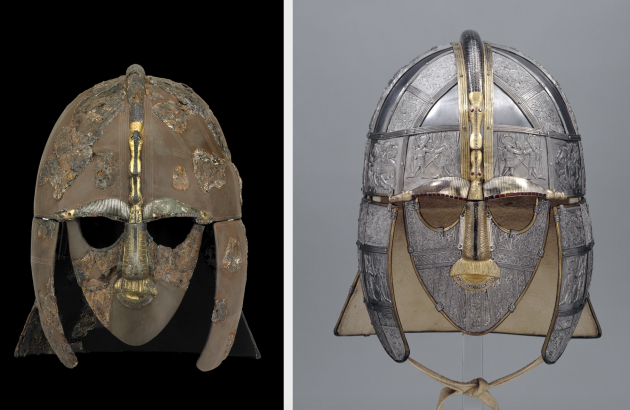Thursday, October 3rd, 2019
Sutton Hoo Burial Ship Anniversary
One of the best blog posts that I read this past summer was on the British Museum blog site. It was written by curator Sue Brunning on the Sutton Hoo ship burial. The post was not only informative, but it was also engaging and written in a way that channeled excitement in me. I was reminded of the reason why I started blogging in the first place.
Brunning’s post was written to commemorate the discovery of the Sutton Hoo ship burial, which took place eighty years ago in 1939. This discovery was monumental and was unprecedented in many ways, since it is one of the most intact burials that has been found in Europe. This ship – which was almost 90 feet long (27 meters), served as the burial place for some extremely important individual (possibly the King of Anglia) in the 7th century. There is some old film footage of the excavation that shows helps to showcase the scale of this find. Probably the closest find in terms of historical weight and scope, I think, was the discovery of King Tut’s tomb in Egypt seventeen years earlier, in 1922.
The Sutton Hoo is sometimes called “Britain’s Tutankhamun,” and an even more recent discovery of a different tomb of a 6th century Anglo Saxon prince has been hailed in the media as “UK’s answer to Tutankhamun.” However, I think that it will take a lot of work to have these British examples overshadow King Tut. It was a King Tut exhibition in the 1970s which created the sensation of the “blockbuster exhibition” in museum culture, and I think this event further helped to solidify the boy king’s status in modern culture today.
In terms of scholarship and archaeological trends, King Tut’s tomb might have gotten more attention because the Egyptian mummy was still intact in its sarcophagus, whereas the remains in the Sutton Hoo ship had decomposed. Without tangible, display-able human remains, there may have been less of a motivation to create an impressive display for the Sutton Hoo items (although in more recent years, a new display of the treasures has been well received). That being said, I think it’s interesting how both burials have some objects that have visual similarities: the Sutton Hoo helmet gives off a ghostly humanoid presence which is akin to King Tut’s sarcophagi and famous funerary mask.

Sutton Hoo helmet (right) with reconstruction (left). Early 7th century, iron and tinned copper alloy helmet, consisting of many pieces of iron, now built into a reconstruction, 31.8 x 21.5 cm (as restored)
Another reason why I think that Sutton Hoo might not get as much attention is that many of the objects found in the burial are either small in scale, such as a purse clasp (shown below), shoulder clasp, and belt. These objects include a lot of minute detail and interlace lines that needs to be seen closely to be observed. I don’t think that these formal elements diminish the historical or aesthetic value of these objects, but I think that the smaller scale might cause the objects to require a more intimate, up-close connection with the viewer. Although there were small-scale objects also found in King Tut’s tomb, larger objects are also found therein and would have been more visually able to reach the masses in a blockbuster exhibition. These large scale objects continue to draw visitors to see King Tut – currently the website for the ongoing exhibition King Tut: Treasures of the Golden Pharaoh 2019-2021 displays a large gilt chariot as one of the highlights of the show.
Sutton Hoo Purse Clasp, early 7th century. Gold, garnet and millefiori, 8.3 x 19 cm (The British Museum). Image courtesy Steven Zucker and Smarthistory via Flickr
Nonetheless, despite that the Sutton Hoo burial is not as much of a household name as “King Tut,” the findings at this excavation are extremely impressive and significant! I’m glad that the British Museum has given these objects a display (and a £4 million revamp at the Sutton Hoo site) that emphasizes their significance. Will these objects ever get to travel around the world in the same way that King Tut’s mummy and tomb objects have? Some Sutton Hoo objects did travel around Suffolk and north Essex while the National Trust display at Sutton Hoo was under renovation, but I’m not aware of any other time that any objects from this excavation have traveled. Does anyone know otherwise?
